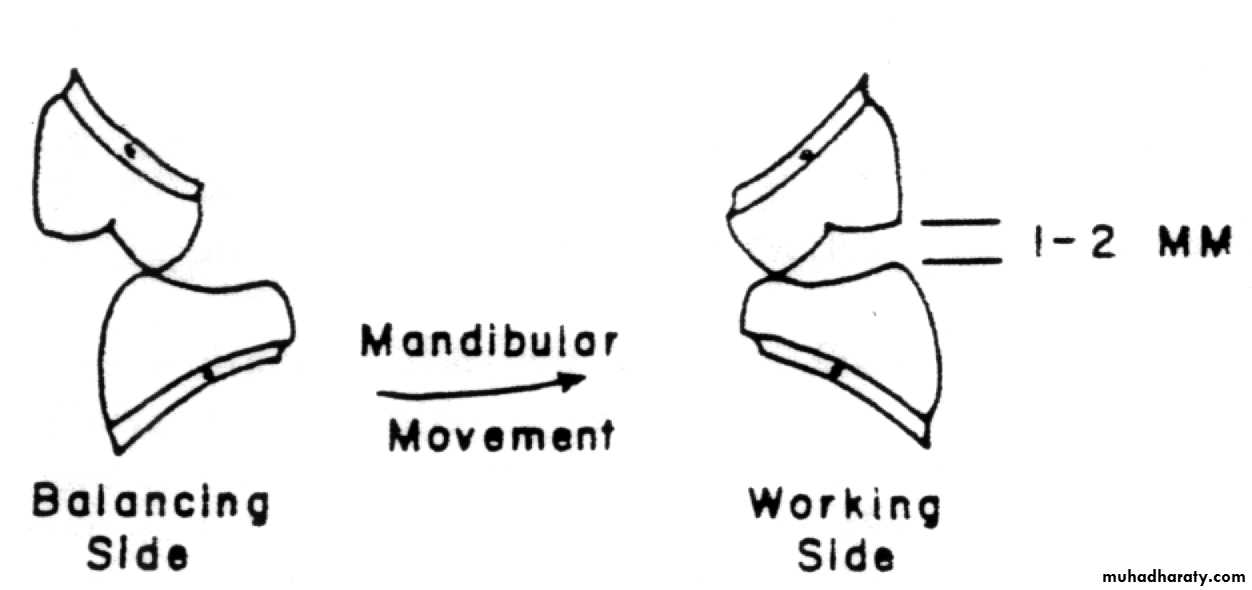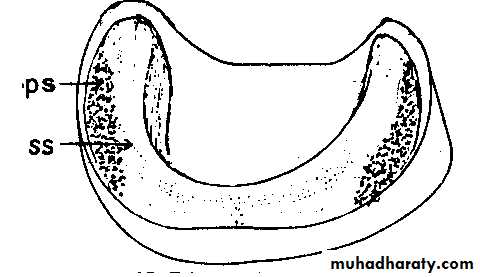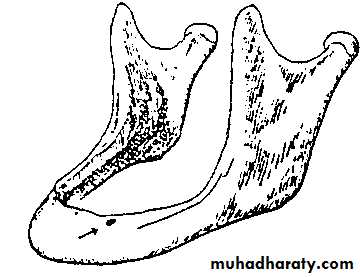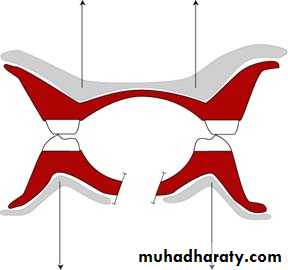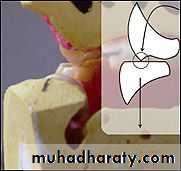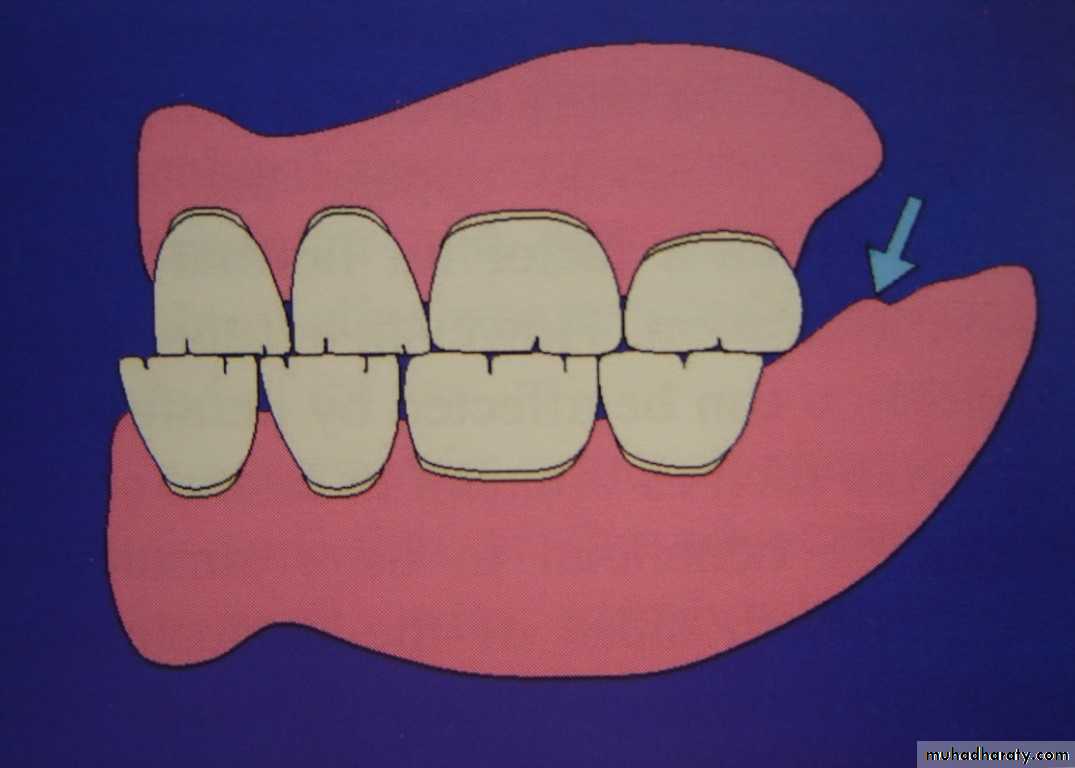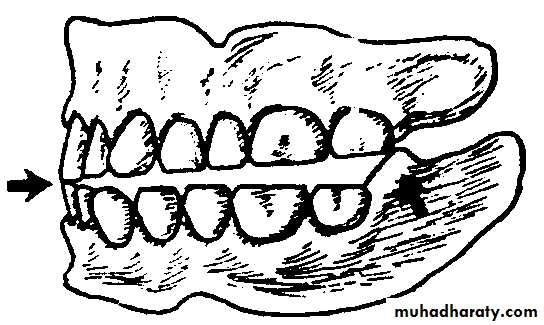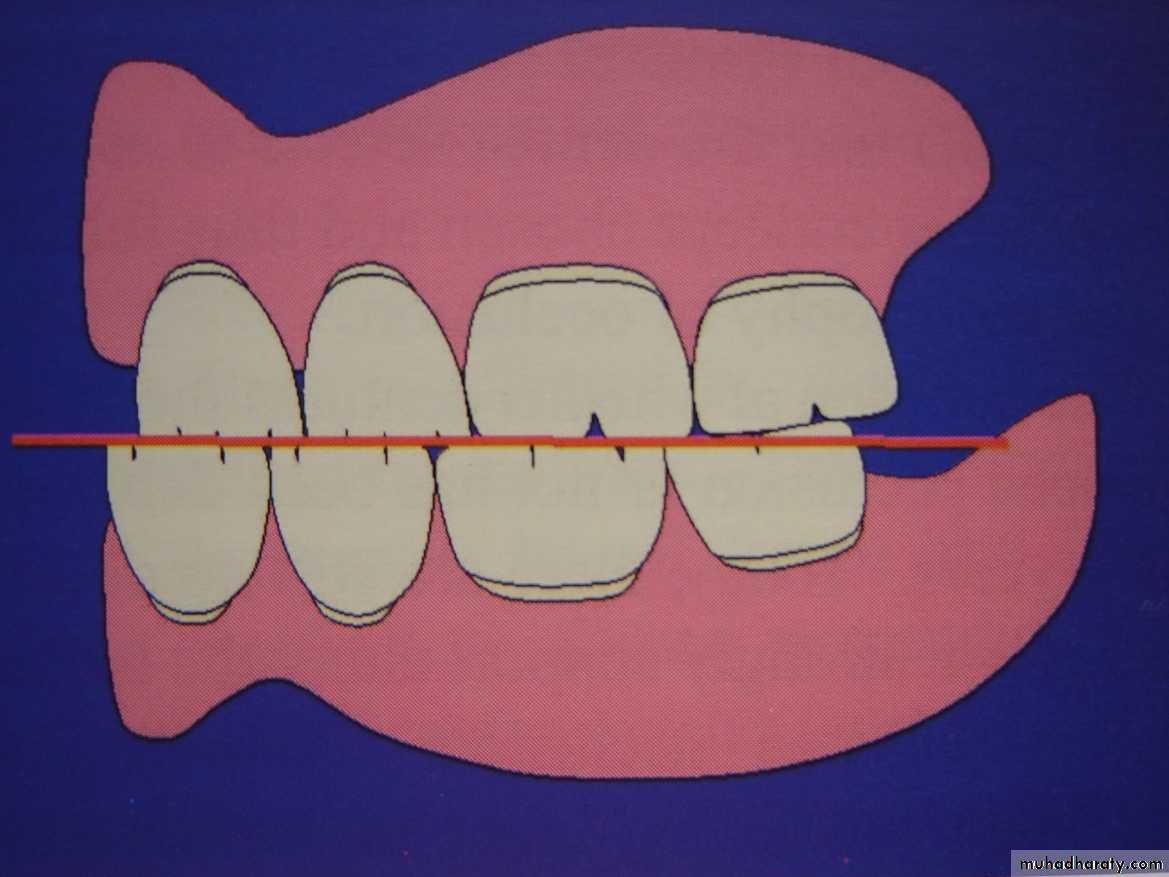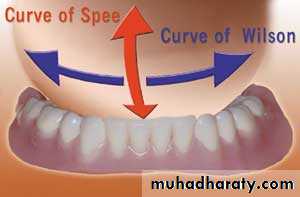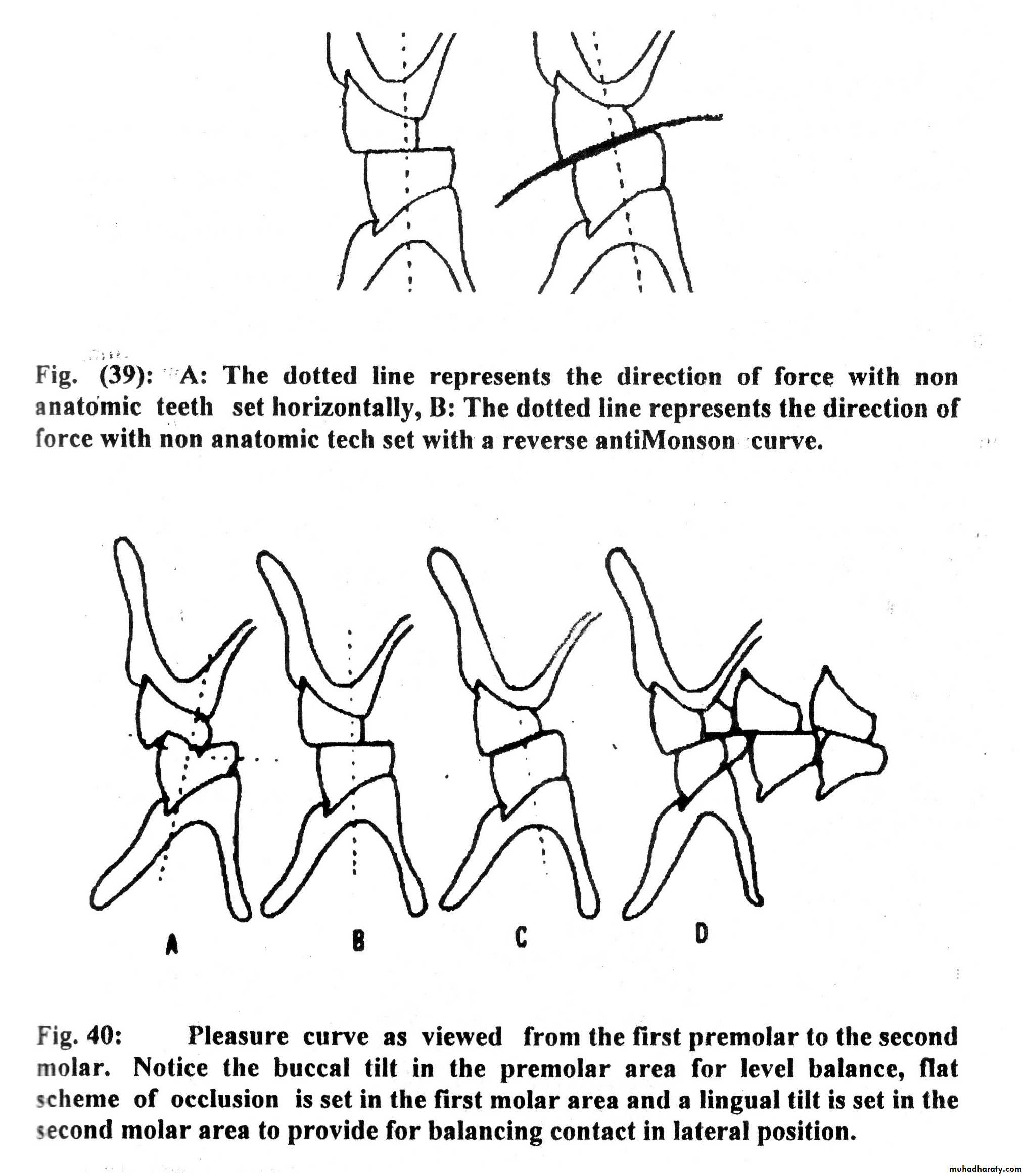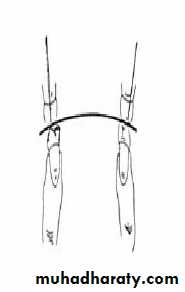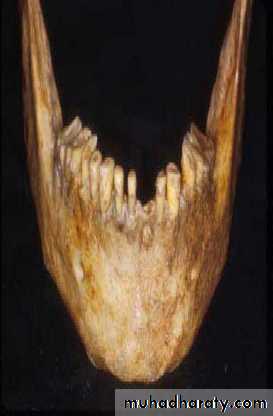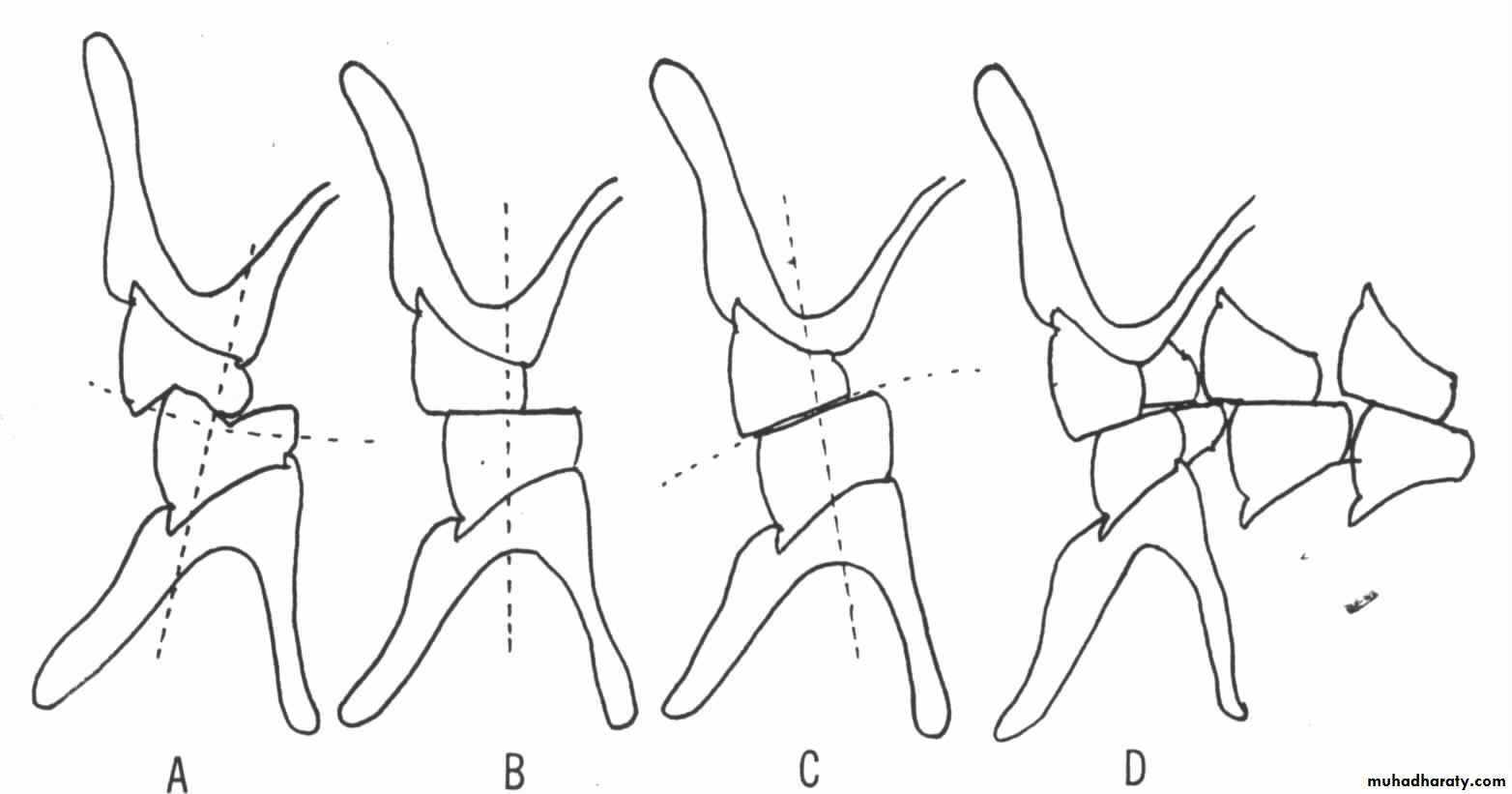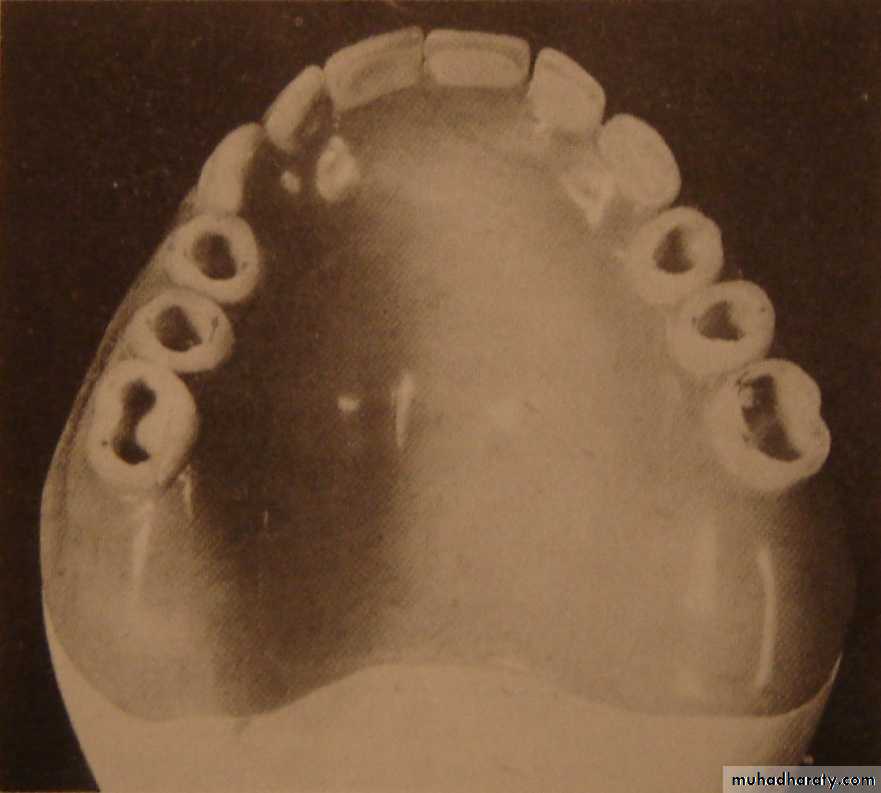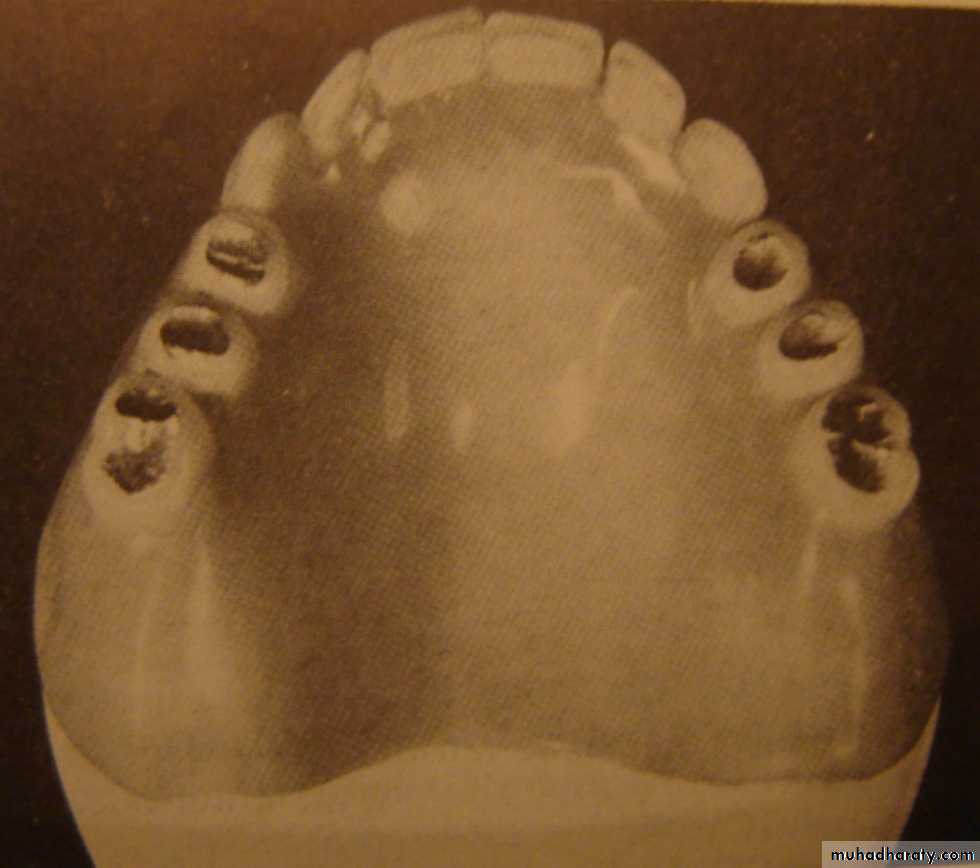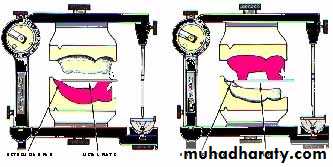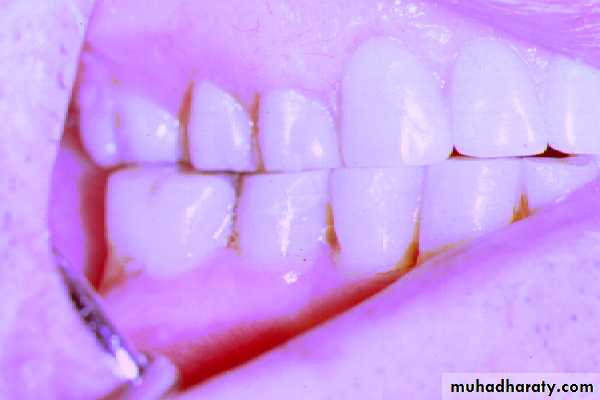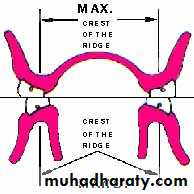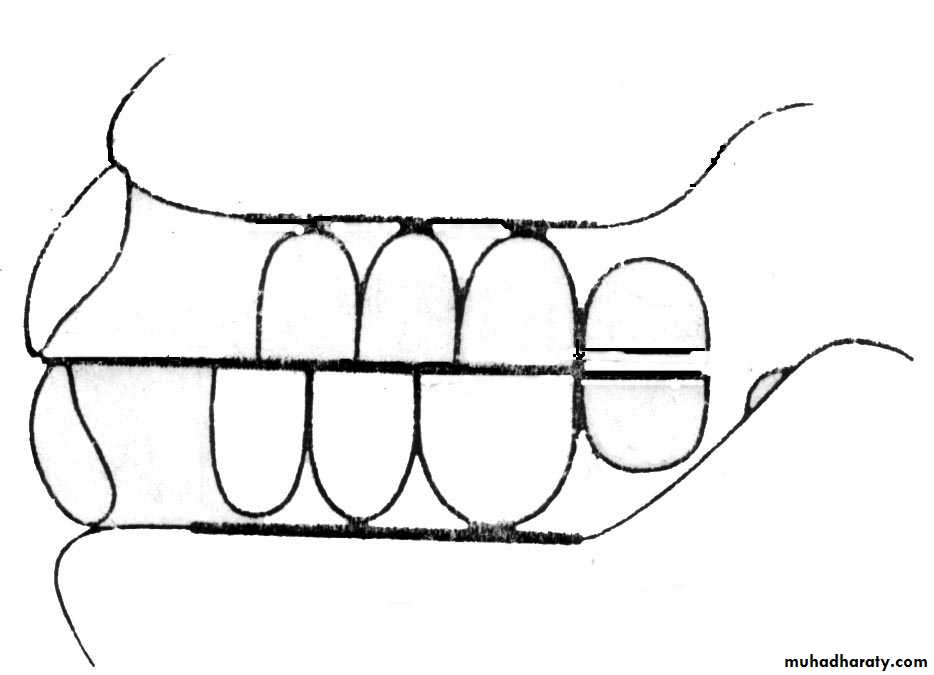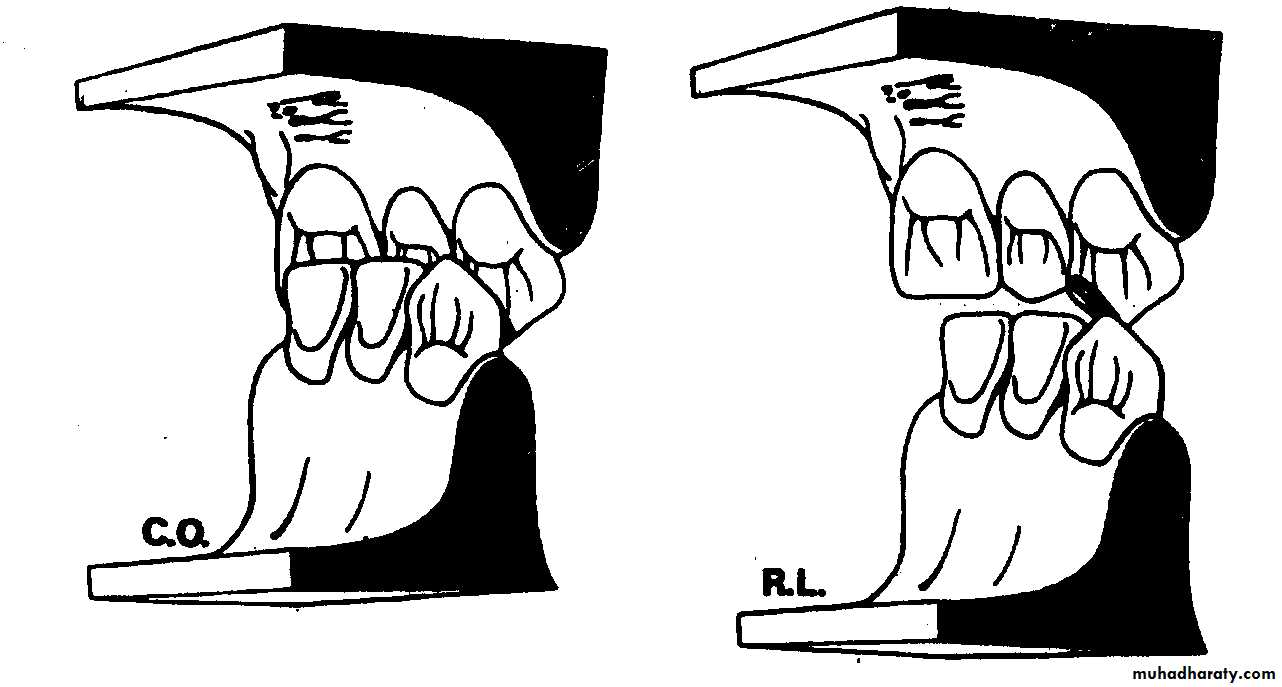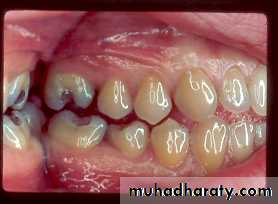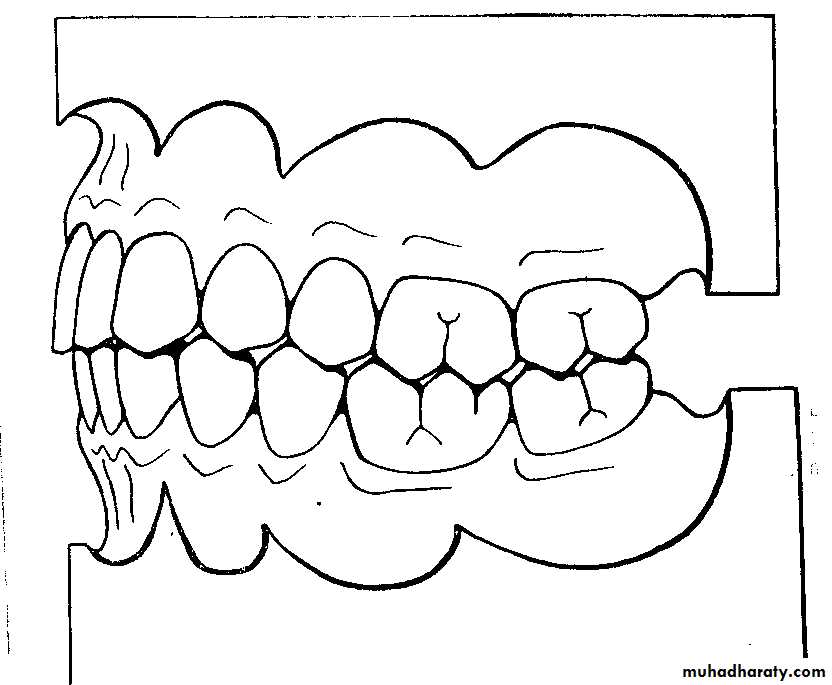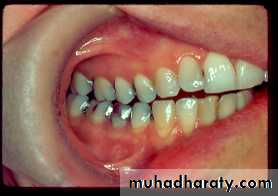COMPLETE DENTURE OCCLUSION
Dr. Monia MN KandilConcepts of OCCLUSION
صناعة اسنان \ خامس
د.منية م6
5-12-2016
Concepts of Occlusion
I- Concepts Of Occlusion In Centric Position.a. Concepts of balanced occlusion
II- Concepts Of Occlusion In Eccentric Position:-
b. Concepts of non-balanced occ.
I-Concepts of Occlusion in Centric Position
1- Point centric.2- Long centric.
3- Slide centric.
4- Power centric.
1- Point centric
Anatomic teeth set in tight interdigitated centric occlusion with an incisal overlap for estheticsI-Concepts of Occlusion in Centric Position
It involves positioning of the teeth with a compensating curves (Spee, Wilson & Monson’s curves) running anteroposteriorly and mediolaterally to simulate natural teeth
Point centric
Spee’s curve
Wilson’s curveMonson’s curve
The point centric concept is that in which centric occlusion coincide with centric relation perfectly, such occlusion in Compl.Dent. is neither stable nor physiologic.
So
Function and stability of complete dentures are well served by the freedom in centric concept
2- Freedom of centric (Long centric)
Once CR is established, CO can be built to coincide with it and provide a broad area of tooth contact in this position called "freedom in centric "Freedom of centric (Long centric)
It is a relatively flat area created between centric relation and centric occlusion positions on the occlusal surfaces of the teeth,(from hinge position to habitual intercuspal position).
Freedom of centric (Long centric)
This flat region, having a length of 0.5-1mm, gives the mandible freedom to close in Centric or slightly anterior to it without any interference or without any changes in vertical dimension .Freedom of centric (Long centric)
When cuspless teeth are used this freedom exists automatically.In both situations (using anatomic or non-anatomic teeth) the anterior teeth are arranged to allow this freedom of movement i.e. enough over-jet & over-bite.
the occlusal surface of the teeth could be altered to allow freedom of tooth movement in harmony with the rotation of condyle. (from hinge position to habitual intercuspal position).
Through wear, caries, loss of teeth or poor dentistry, sliding movement that the mandible makes as it moves from retruded contact position to intercuspal position i.e. the slide is often a combination of forward and lateral movements, as well as vertical components
3- Slide in Centric (eccentric slide)
Slide in Centric
Q: Does the mandible really “slide” into MI from the Retruded Contact Position during closure (not chewing) ?A: No, it closes along an arched path which leads directly to MI position.
Q: What is the name of this path?
A: Habitual Arc of Closure
Posselt’s Figure
MP
MO
ICP
RCP
HA
MP = Maximal protrusion
ICP = Intercuspal position
RCP= Retruded Contact position
HA = Hinge axis
MO = Maximum opening
EE=edge to edge
Posselt’s Figure
Habitual Arc of Closure
Habitual Arc of ClosureIn that case the intercuspal position is in a position forward to the centric position, and at a lower vertical dimension
Point Centric
Slide in Centric
Freedom in centric
“Slide” In Centric
RC POSITIONMI POSITION
Pin Height
MI POSITION
RC POSITIONPin Height
VERTICAL SLIDE
HORIZONTAL SLIDEHABITUAL ARCH OF CLOSURE
CR=HINGE AXISMeasuring Amount of Slide
RC POSITION
Pin Height
Correcting the slide RC MI
CUT #1: HOLLOW GRIND FOSSA MESIAL-FACING SLOPE OF UPPER TEETH(MU)
CUT #2: HOLLOW GRIND FOSSA DISTAL-FACING SLOPE OF LOWER TEETH
(DL)
The Mandible is now free to move UP along the Hinge Axis to the Correct Vertical Dimension without being forced to slide forward
GRINDING RULE = MUDL (Mesial-facing Upper/Distal-facing Lower)
CR OCCLUSION
Pin Height“OLD” MI POSITION
“LONG” CENTRICThe Result…
Should there be centric on Anteriors ?
Anterior teeth are arranged to allow freedom of movement i.e. the anterior teeth are not arranged in contact when the jaws are in centric relation.
Anterior Contacts in “old” MI and CRO after Correction
4- Power centricThe patient close against force and determining the position of the mandible in which the patient could bite the hardest. This position does not necessarily correspond to any of the three previously mentioned "centrics" since it is based on a different premise.
Concepts of Occlusion
I- Concepts Of Occlusion In Centric Position.a. Concepts of balanced occlusion
II- Concepts Of Occlusion In Eccentric Position:-
b. Concepts of non-balanced occ.
Balanced occlusion in eccentric position is usually associated with cusp form posterior teeth, with the exception of organic occlusion, that employs cusp form posterior teeth that are not arranged to provide protrusive and bilateral balance.
A-Concepts of Balanced Occlusion in Eccentric Position
Spherical theory of occlusion.
Centralizing concept of occlusion.Lingualized occlusion concept (Gysi).
4. Linear occlusion concept.
5. Balance with non-anatomic teeth.
a. Zero Degree Teeth with Balancing Ramp.
b. Tilting the second molars.
c. Zero Degree Teeth with a Compensating Curve
d. Reverse curve of Wilson.
e. Max Pleasure’s modified occlusion.
6. Dynamic occlusion (functional generated path)
Occlusal Designs of Balanced Occlusion:
A-Concepts of Balanced Occlusion
1- Spherical Concept of Occlusion
Positioning artificial anatomic posterior teeth to simulate natural occlusion. The teeth, must be arranged with a compensating curve running anteroposteriorly and mediolaterally
Anatomic or semi anatomic teeth are arranged in point centric occlusion.
Max. arch alignments of cusped posterior teeth and the mand. Residual ridge as a landmark for setting teeth
Spherical concept of occlusion
The position Of the tooth in relation to the ridge is the important factor in controlling the force and its effect on stability of the base
Spherical concept of occlusion
Spherical concept of occlusion
Teeth make contact in lateral excursion on the working and balancing sides
Excursive Movements
Protrusive movementExcursive Movements
Laterotrusive and MediotrusiveNon-working Side (Mediotrusive)
Working Side(Laterotrusive)
LEFT MANDIBULAR EXCURSION
Distribution of masticatory pressure over the supporting tissues help in:Advantages of arrangement teeth with Spherical concept:
Increased stability of the dentures during functional and parafunctional movements of the mandible.
Reduced trauma to the underlying tissues.
Increased efficiency of mastication
2-The Centralizing Occlusion Concept:
(Balanced occlusion by centralization of forces)
The concept of centralizing the working occlusal surfaces requires bringing the occlusal surfaces toward the center of the denture foundation to their ideal positions for favorable leverage
The Centralizing Occlusion Concept:
Most favorable leverage is obtained when the occlusal working surfaces are placed to the lingual sides of the ridge crests .The second molars are not always placed in the arrangement; or are placed out of occlusion.Why?
Working occlusal units ideally consist of the lingual halves of the two maxillary bicuspids and the first molar and their corresponding mandibular teeth.
The Centralizing Occlusion Concept:
New occlusal theory “Occlusal power zone” (Power Zone = E zone)As people age their number of teeth decrease, the temporomandibular joint collapses and the movable area of the mandible gets wider.
There is one thing that doesn’t change as people age, that is the origin and insertion of the orbicularis oris muscle, which is pulling the mandible.
It is hypothesized that there is an occlusal area (Power Zone) provided by the orbicularis oris muscle, where the best usage is given without any biomechanical change.
this area located in the upper deciduous molar (from the upper mesial-second premolar to the upper mesiobuccal cusp-first molar. This zone is the most important for the stability of the denture as well as mastication
3- The Lingualized Occlusion
A method to achieve bilateral balanced occlusion with an attempt to maintain the esthetic and food penetration advantages of the anatomic form while maintaining the mechanical freedom of the non-anatomic formAdvantages of lingualized occlusion:
• 1. Esthetics is maintained.• 2. Efficiency is maintained.
• 3. Mechanical freedom of occlusion from the non-anatomic teeth form.
• 4. Mechanical stability due to centralized forces.
• 5. Bilateral balanced occlusion is readily obtained for a region around centric relation.
• 6. No lateral forces due to one contact point.
• 7. Lingualized occlusion can be used with all morphologic ridge contours.
• 8. Buccal cusp tilt allows escape way for the bolus of food.
The maxillary buccal cusps are not in contact, leaving only the maxillary lingual cusps as the centric holding cusps,
which helps to stabilize the upper and lower dentures and minimizes the number of tooth contacts
Reducing the efficiency of the lower buccal cusps, Vertical forces are centralized on the mandibular teeth. thus directing the forces to the lingual side of the lower ridge crest to encourage lever stability of the lower denture.
The maxillary cusps act also as the centric holding cusps. This give mortar and pestle type contact that lingualizes the resultant force without moving the teeth in relation to the ridge.
Maxillary lingual cusp make a point of contact somewhere along the mandibular central fossa.
Eliminate anterior interferences
In Centric occlusion
(A) when considerable horizontal overlap is present between the anterior teeth. Esthetic vertical overlap of the teeth can be accommodated.(B) When little horizontal overlap then the vertical overlap must be reduced to approach
In Protrusive movement is possible while maintaining balanced occlusion with minimal vertical overlap of anterior teeth.
Selective grinding of mandibular tooth forms is needed to create a slight concavity in the occlusal surface.: Left. Shallow cusp form: right. 0 degree cusp form
In lateral excursive movements clearance between the maxillary and mandibular buccal cusps to increase lever stability to the lower denture.
• In Bilateral eccentric equilibration
Maintaining teeth on the ridge preserves lever balance
Lingualized occlusion helps centralization of forceLingual bone resorption prevents placing teeth within the neutral zone
4- Linear Occlusion Concept of Complete Dentures
The decision as to whether to locate the linear ridge of contacts in the maxillary or mandibular arch depends on the factors of denture stability and estheticsThe idea is to minimize the force penetrating food by sharp linear contact between the upper and lower posterior teeth. A line of occlusal contact in one dental arch occluding with a flat occlusal table in the other dental arch,
• Placing "balancing ramps" behind the lower second molars.
• Tilting the second molars to create an inclined plane.• Arranging teeth in a compensating curves.
• Anti Monson curve.
• Pleasure curve.
A- Zero Degree Teeth with Balancing Ramp
Setting up the teeth in a flat plane and utilize a balancing ramp just distal to the second molar.
artificial tooth
an acrylic ramp,non anatomic porcelain teeth
Amalgam or gold balancing ramp
Types of balancing ramps
Sears advocated the use of second molar ramp which is adjusted to provide protrusive and lateral balance (three point balanced occlusion),
Protrusive Balance Compensation in Monoplane Denture occlusion: Second Molar Slant
B- Tilting the second molars
C- Zero Degree Teeth with a Compensating CurveZero degree teeth can be set on lateral and anteroposterior curves harmonious with the condylar inclination to attain reasonable balance contacts in lateral and protrusive positions.
d- Reverse curve of Wilson
skull with a reverse curve of Wilson.e- Max Pleasure’s modified occlusion:
A reverse curve is used in the bicuspid area (C) for a lever balance, A flat scheme of occlusion is set in the first molar (B), and a spherical scheme set in the second molar area (A) by raising the buccal incline to provide for balancing contact in lateral position. The distal of the second molar can also be elevated to produce a compensating curve for protrusive balance.Disadvantages of Non-Anatomic Occlusion
AestheticsMastication
Encourages lateral movement bruxism
Christensen’s Phenomenon
6- Functional Occlusion (Dynamic Occlusion)
The ultimate harmonious balanced occlusal form because the patient generates it by himself resulting in an occlusion that is in harmony with T.M.J and neuromuscular system. This occlusion will allow freedom in lateral excursions and maintain maximum bilateral contact in function.
Functionally generated occlusion:
Concepts of Occlusion
I- Concepts Of Occlusion In Centric Position.a. Concepts of balanced occlusion
II- Concepts Of Occlusion In Eccentric Position:-
b. Concepts of non-balanced occ.
We forced to such concept because:
The character of the supp. foundation & mucosa resiliency make it almost impossible to harmonize tooth arrangement with mand. movements in the eccentric relations.B- Concepts of Non-Balanced Occlusion In Eccentric Position
To minimize horizontal forces that are unstabilizing and potentially destructive to the supp. tissue.
When the jaws are in CR and the contact of the teeth produces no discomfort to the supp. tissues or the joints
Advantages of non-balanced Occlusion
• Simple technique.
• No lateral forces.
• Freedom of occlusion.
• Used with compromised ridges.
• Necessitates minimum adjustments.
• Poor esthetics.
• Poor masticatory efficiency.• No balancing contacts.
• Restricted protrusion and incision.
• Lateral chewing cycle.
Disadvantages of non-balanced Occlusion
1- Monoplane Occlusion
Advantages of monoplane occlusion:(Non-Anatomic Occlusion)
Non-BalancedDoes not require precision with records.
By removing any inclines, destructive forces on residual ridges is reduced.
Easier to adjust.
Freedom in CR
Cross-bite patients
Non- anatomic teeth with flat occlusal surfaces set to a flat occlusal plane
Posterior horizontal overlap
of flat plane teethMonoplane Occlusion
The posterior limit of the lower posterior teeth is the point at which the mandibular ridge begins to curve upward, with elimination of contact between the upper and lower second molars.The patients should avoid incising with their anterior teeth
2- Neutrocentric Concept of OcclusionNeurocentric two objectives in denture construction.
A- Neutralization of inclines.
B- Centralization of occlusal forces acting on the denture foundations.
Neutrocentric Concept of Occlusion
1- Neutralization of inclines (elimination of inclines):a- Orientation of occlusal plane.
b- compensating curve, and
c- Incisal guidance, no cusp angle.
Neutrocentric Concept of Occlusion
2- Centralization of occlusal forces acting on the denture foundation, to have:a- Superior stability.
b- preservation of ridge bone.
c- Good appearance, adequate speech and mastication.
Five factors are involved, to achieve these 2 objectives:
Position of Posterior teeth in a central position.Proportion of the teeth 40% reduction in the width.
Plane of occlusion is parallel with the mean denture foundation area.
Form of teeth devoid of projecting cusps.
Number of teeth reduction in number.
3- Organic Occlusion
Concept that employs cusp form posterior teeth that are not arranged in protrusive or lateral balance.
Organic concept of occlusion can not be accepted, in constructing complete dentures
Eg. For organic occlusion Canine GuidanceNot applied for denture construction
Canine Guidance / Rise / Canine Protected Articulation
4-The group function concept.
In which two or more or all of the teeth other than the canines, in contact on the working side and no balancing contacts for either the right or left lateral functional excursions (natural occlusion)































